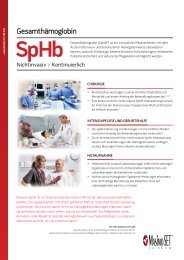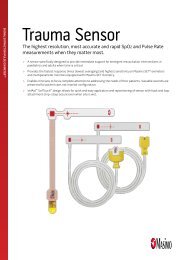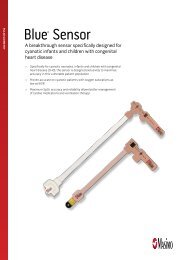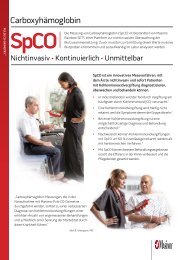Carboxyhemoglobin - Masimo
Carboxyhemoglobin - Masimo
Carboxyhemoglobin - Masimo
You also want an ePaper? Increase the reach of your titles
YUMPU automatically turns print PDFs into web optimized ePapers that Google loves.
Acute care is now able to realize the untapped potential of noninvasive<br />
Pulse CO-Oximetry, a technology cleared for market<br />
by the FDA, readily available, fully validated and easy to use. 71<br />
There is good reason to believe that this technology will have<br />
a positive impact on mortality and morbidity statistics in the<br />
hospital.<br />
With patient safety awareness issues elevated to<br />
unprecedented levels, the ca se for noninvasive and continuous<br />
monitoring of the critical dyshemoglobins COHb and MetHb<br />
has never been more compelling. Without monitoring COHb,<br />
patients remain vulnerable to known but preventable toxic<br />
episodes involving carbon monoxide.<br />
References<br />
1 Layne T, Snyder C, Brooks D, Enjeti. Evaluation of a New Pulse CO-Oximeter:<br />
Noninvasive Measurement of <strong>Carboxyhemoglobin</strong> in the Outpatient<br />
Pulmonary Lab and Emergency Departments. Pulmonary Physiology Department,<br />
Erlanger Health System, Chattanooga, TN.<br />
2 Partridge R, Chee KJ, Suner S, Sucov A, Jay G. Non-Invasive <strong>Carboxyhemoglobin</strong><br />
Monitoring: Screening Emergency Department Patients for Carbon<br />
Monoxide Exposure. Department of Emergency Medicine, Rhode Island<br />
Hospital, Brown Medical School, Providence, RI.<br />
3. Janshon GP, Dudziak R: Interactions of dry soda lime with enfl urane and<br />
sevofl urane. clinical report on two unusual anesthesias. Anaesthesist.<br />
1997;46:1050-3.<br />
4. Woehlck HJ, Dunning MB III, Connolly L: Reduction in the incidence of<br />
carbon monoxide exposures in humans undergoing general anesthesia.<br />
Anesthesiology. 1997;87:228-34.<br />
5. Woehlck HJ, Dunning M III, Gandhi S, Chang D, Milosavljevic D: Indirect detection<br />
of intraoperative carbon monoxide exposure by mass spectrometry<br />
during isofl urane anesthesia. Anesthesiology. 1995;83:213-7.<br />
6. Fang ZX, Eger EI II, Laster MJ, Chortkoff BS, Kandel L, Ionescu P: Carbon<br />
monoxide production from degradation of desfl urane, enfl urane, isofl urane,<br />
halothane, and sevofl urane by soda lime and Baralyme. Anesth Analg<br />
1995;80:1187-93.<br />
7. Woehlck, HJ. [Editorial Views] Severe Intraoperative CO poisoning: should<br />
apathy prevail? Anesthesiology: Volume 90(2) February 1999 pp 353-354.<br />
8. Woehlck HJ, Dunning MB III, Connolly L: Reduction in the incidence of<br />
carbon monoxide exposures in humans undergoing general anesthesia.<br />
Anesthesiology. 1997;87:228-34.<br />
“How Many People Are We Missing?”<br />
Ann left New York in 2005 to retire in<br />
the warm Florida weather. She rented<br />
a condominium in a newly renovated<br />
building in the Tampa area. Within<br />
months she became increasingly ill,<br />
collapsed, and was rushed to a local<br />
hospital for a battery of tests over several<br />
days, all negative. Her condition<br />
improved, and she was sent home<br />
where her symptoms returned. After<br />
her headaches, fatigue, and fl u-like<br />
symptoms progressed to convulsions,<br />
she was transported to a different<br />
hospital where she was properly diagnosed<br />
with carbon monoxide poisoning.<br />
Ann died from the exposure to<br />
the toxic CO gas that seeped into her<br />
condo via holes in her chimney fl ue.<br />
Because new technology is now available<br />
to detect the blood levels of carbon<br />
monoxide without a blood sample,<br />
her mourning daughter wonders why<br />
every hospital does not have access<br />
to this test that could save so many<br />
lives. Mary Russell, EdD MSN, and a<br />
Research & Organizational Preparedness<br />
Specialist at Boca Raton Community<br />
Hospital, uses and trains on<br />
the new detection technology. She<br />
asks the question: “How many people<br />
are we missing?”<br />
9. Janshon GP, Dudziak R: Interactions of dry soda lime with enfl urane and sevofl urane. clinical report on two unusual anesthesias. Anaesthesist.<br />
1997;46:1050-3.<br />
10. Woehlck HJ, Dunning MB III, Connolly L: Reduction in the incidence of carbon monoxide exposures in humans undergoing general anesthesia.<br />
Anesthesiology. 1997;87:228-34.<br />
11. Woehlck HJ, Dunning M III, Gandhi S, Chang D, Milosavljevic D: Indirect detection of intraoperative carbon monoxide exposure by mass<br />
spectrometry during isofl urane anesthesia. Anesthesiology. 1995;83:213-7.<br />
12. Berry PD, Sessler DI, Larson MD: Severe carbon monoxide poisoning during desfl urane anesthesia. Anesthesiology. 1999;90:613-6.<br />
13. Allred EN, Bleecker ER, Chaitman BR, Dahms TE, Gottlieb SO, Hackney JD, Pagano M, Selvester RH, Walden SM, Warren J: Short-term<br />
effects of carbon monoxide exposure on the exercise performance of subjects with coronary artery disease. N Engl J Med. 1989;321:1426-<br />
32.<br />
14. Anderson EW, Andelman RJ, Strauch JM, Fortuin NJ, Knelson JH: Effect of low-level carbon monoxide exposure on onset and duration of<br />
angina pectoris. a study in ten patients with ischemic heart disease. Ann Intern Med. 1973;79:46-50.<br />
15. Seger D, Welch L: Carbon monoxide controversies: neuropsychologic testing, mechanism of toxicity, and hyperbaric oxygen. Ann Emerg<br />
Med. 1994;24:242-8.<br />
16. ECRI Editorial Staff: Carbon monoxide exposure during inhalation anesthesia: the interaction between halogenated anesthetics agents and<br />
carbon dioxide absorbents (Hazard Report). Health Devices. 1998;27(11):402-4).<br />
17. Woehlck, HJ. [Editorial Views] severe intraoperative CO Poisoning: should apathy prevail? Anesthesiology: Volume 90(2) February 1999 pp<br />
353-354.<br />
18. Sethi, JM. Carbon monoxide. Crit Care Med. 2005 Vol. 33, No. 12 (Suppl.).<br />
19. Peterson JE, Stewart RD. Absorption and elimination of carbon monoxide by inactive young men. Arch Environ Health. 1970;21:165–71.






